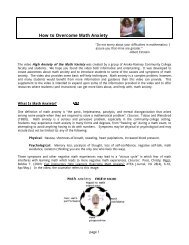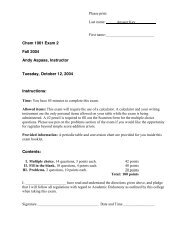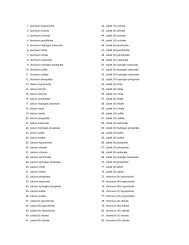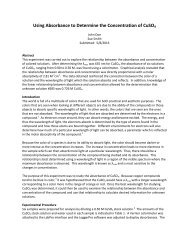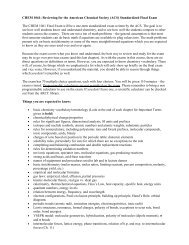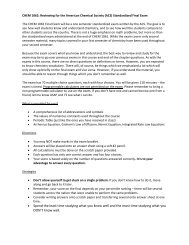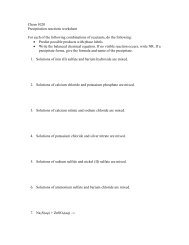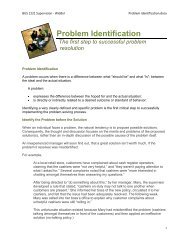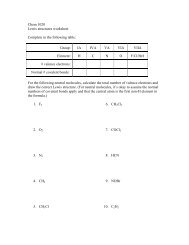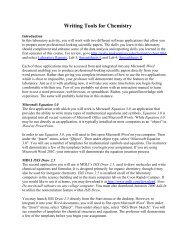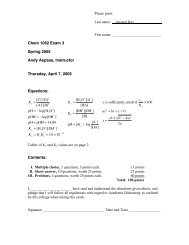Microscale Density And Refractometry
Microscale Density And Refractometry
Microscale Density And Refractometry
You also want an ePaper? Increase the reach of your titles
YUMPU automatically turns print PDFs into web optimized ePapers that Google loves.
16. Calculate the density of the unknown liquid for each trial using the mass of the liquid and the<br />
average volume of the pycnometer. Determine the average density of the liquid.<br />
17. Determine the refractive index of your unknown liquid. (Your instructor will demonstrate<br />
how to use a refractometer). Wipe off the unknown liquid with a KimWipe® and repeat the<br />
determination of your refractive index one more time with a new sample of your unknown<br />
liquid. When you are finished, wash the prism with a SMALL amount of acetone and dry it<br />
again gently with a KimWipe®.<br />
18. Use the table below to identify your unknown.<br />
Substance<br />
20<br />
4<br />
b .p. (°C)<br />
20<br />
d (g/mL) n<br />
4<br />
760<br />
Cyclohexane 0.7786 1.4266 80.7<br />
Cyclohexanol 0.9624 1.4641 161.1<br />
Diethyl ether 0.7134 1.3550 34.6<br />
Ethyl acetate 0.9003 1.3723 77.1<br />
Hexane 0.6603 1.3751 69.0<br />
Isopropyl alcohol 0.7851 1.3772 82.5<br />
Methyl alcohol 0.7915 1.3292 64.7<br />
Toluene 0.8669 1.4961 110.6<br />
PRECISION OF DATA<br />
At this stage, you have probably determined the identity of your unknown. However, you have<br />
not determined the precision of your data. The precision of your data may be determined by<br />
using a statistical calculation called the standard deviation. To learn more about calculating<br />
various statistical functions such as the mean and standard deviation, go to the Statistics link at:<br />
http://webs.anokaramsey.edu/chemistry, click on “Chem 1061”, then click “<strong>Microscale</strong> <strong>Density</strong>”,<br />
then “Chemistry Statistics”.<br />
For help with various calculators, go to one of the following links. In particular, the Texas<br />
Instruments link contains a wealth of information, including online manuals.<br />
Texas Instruments: http://education.ti.com/<br />
Casio: http://www.casio.com, follow the links to “Calculators”<br />
Sharp: http://www.sharp-usa.com/products/FunctionLanding/0,1050,4,00.html<br />
Hewlett-Packard: http://www.hp.com/calculators<br />
LABORATORY REPORT<br />
Include the following information in your laboratory report, due at the beginning of the<br />
laboratory period next week. At your instructor’s discretion, individual or pair reports may be<br />
required.<br />
1. Title (including name, partner’s name, etc.)<br />
2. A description of the procedure you followed to produce the experimental data and results.<br />
Alternatively, you may reference the procedure by citing the URL’s (web addresses).



